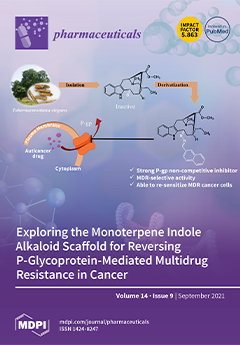Chiral total syntheses of both enantiomers of the
anti-MRSA active plymuthipyranone B and all of the both enantiomers of three unnatural and synthetic analogues were performed. These two pairs of four chiral compounds are composed of the same 3-acyl-5,6-dihydro-2
H-pyran-2-one structure.
[...] Read more.
Chiral total syntheses of both enantiomers of the
anti-MRSA active plymuthipyranone B and all of the both enantiomers of three unnatural and synthetic analogues were performed. These two pairs of four chiral compounds are composed of the same 3-acyl-5,6-dihydro-2
H-pyran-2-one structure. The starting synthetic step utilized a privileged asymmetric Mukaiyama aldol addition using Ti(O
iPr)
4/(
S)-BINOL or Ti(O
iPr)
4/(
R)-BINOL catalysis to afford the corresponding (
R)- and (
S)-δ-hydroxy-β-ketoesters, respectively, with highly enantiomeric excess (>98%). Conventional lactone formation and successive EDCI-mediated
C-acylation produced the desired products, (
R)- and (
S)-plymuthipyranones B and three (
R)- and (
S)- synthetic analogues, with an overall yield of 42–56% with a highly enantiomeric excess (95–99%). A bioassay of the
anti-MRSA activity against ATCC 43300 and 33591 revealed that (i) the MICs of the synthetic analogues against ATCC 43300 and ATCC 33591 were between 2 and 16 and 4 and 16 μg/mL, respectively, and those of vancomycin (reference) were 1 μg/mL. (ii) The natural (
S)-plymuthipyranone B exhibited significantly higher activity than the unnatural (
R)-antipode against both AACCs. (iii) The natural (
R)-plymuthipyranone B and (
R)-undecyl synthetic analogue at the C6 position exhibited the highest activity. The present work is the first investigation of the SAR between chiral
R and
S forms of this chemical class.
Full article






